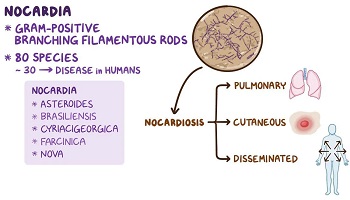Nocardia spp. - Pathogenesis, Clinical manifestation
Pathogenesis of Nocardia
In 90% of cases, Nocardia asteroides is the causative agent of infection. The opportunistic pathogen causes supportive necrosis with abscess formation such as cutaneous, lymph-cutaneous, and subcutaneous nocardiosis, pleuropulmonary disease, and disseminated infection.
The cutaneous infection starts with local trauma from where Nocardia can enter the subcutaneous tissue. Disseminated infection occurs mostly in immunocompromised individuals.
Pleuropulmonary infection, caused by Nocardia, occurs by inhalation of aerosol by immunocompromised individuals. The bacteria colonize the oropharynx and aspiration of pleural secretion in LRT occurs.

Fig: Nocardia transmission (Source: Osmosis)
Clinical Manifestations of Nocardia
The clinical manifestations of Nocardia includes:
primary cutaneous nocardiosis
cutaneous nocardiosis
bronchopulmonary infection
secondary CNS function
Primary cutaneous nocardiosis
Primary cutaneous nocardiosis is feet and hand-cutaneous, lympho-cutaneous infection
Cutaneous infection
Chronic skin infection such as cutaneous infection is characterized by subcutaneous swelling, suppuration, and the presence of multiple sinuses. It is an invasive infection that destroys underlying bone and connective tissue.
As infection progress, multiple sinuses open to the surface with exudation or pus. Pus typically contains sulfur granules (containing Nocardia bound together by Ca-PO4).
Bronchopulmonary infection
In Bronchopulmonary infection, production of inflammatory endobronchial mass, localized or generalized abscess occurs. Other syndromes include the formation of cavities, abscesses in the lungs, and pleural effusion.
Cough with sputum and fever are also symptoms observed in patients.
Secondary CNS function
In Secondary CNS function, the infection may spread to the CNS through skin, subcutaneous tissue, kidney, joint bone, heart, and eye.
a brain abscess or chronic meningitis